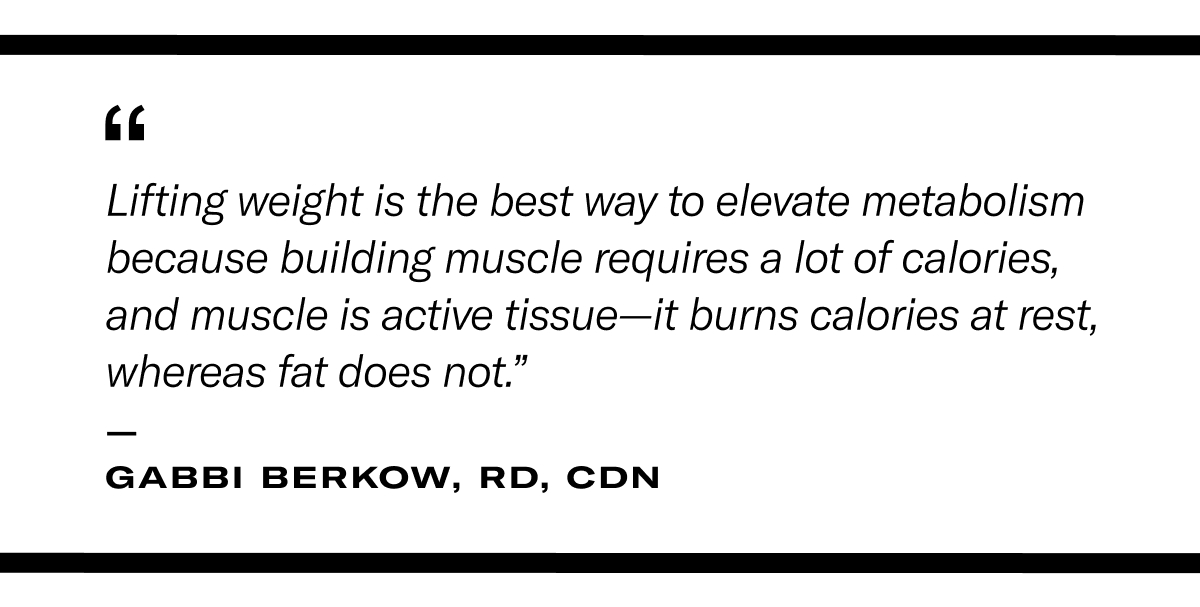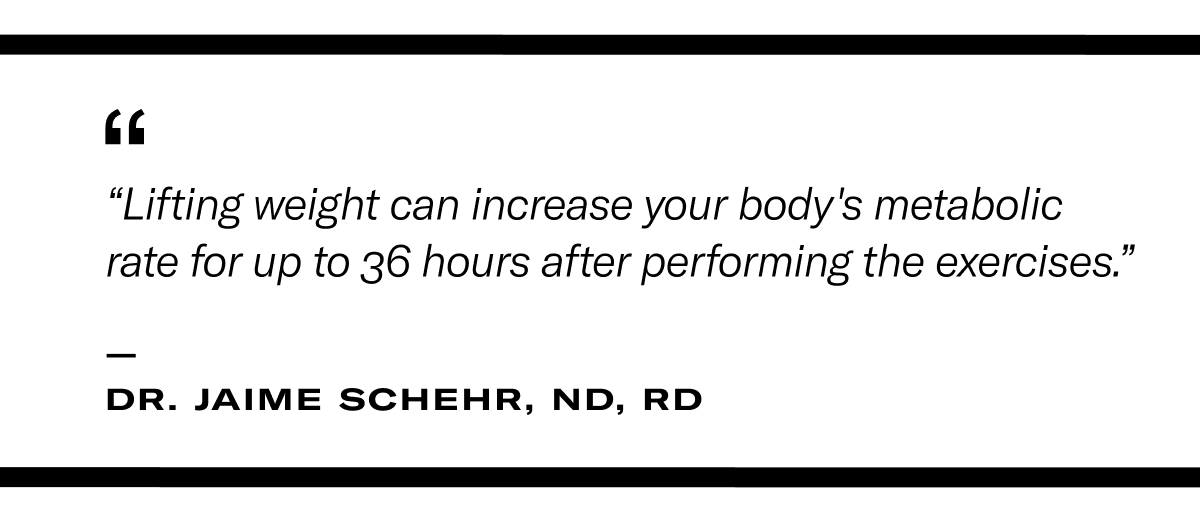Lifting regularly revs up your metabolism. Make sure you satisfy those hunger pangs.

If you’ve recently added strength training to your fitness routine, chances are you already feel more powerful and confident, and are even sleeping more soundly. But you might also notice other sensations as well, like feeling hungrier than usual. It’s not all in your head: Your body is not so subtly sending “feed me” signals. So what gives? Why does strength training make you more hungry? And how can you properly fuel your workouts so you keep seeing progress and hitting your goals? It all starts with your metabolism.
What Is Metabolism and Why Does It Matter?
Everyone has heard the term “metabolism” (often in the context of products promising to rev it, boost it, and send it into high-speed mode), but what is it exactly? In plain terms, your metabolism is the series of internal processes that allow your body to convert food and beverages (in the form of calories) into energy. That energy, in turn, powers all the essential functions your body performs (like breathing and digestion), so you need to take in a certain number of calories every day just to ensure those functions go smoothly. That minimum number of calories is called your basal metabolic rate, or BMR.
Experts aren’t clear on all the complex factors that determine the speed of metabolism, i.e. how quickly a body converts calories to energy. They do know, however, that metabolism has an influence on your ability to gain or lose weight. A “slow” metabolism burns fewer calories, meaning your body is more likely to store fat, while a “fast” metabolism burns more calories. Age and genetics both play major roles in this metabolic rate, but there are some modifiable lifestyle factors that contribute, too, and perhaps the most influential one is muscle mass.
Why Does Strength Training Make You More Hungry?
“Metabolism increases dramatically when someone starts strength training,” explains Gabbi Berkow, MA, RD, CDN, CPT, a registered dietitian, exercise physiologist, and certified personal trainer and Pilates instructor. “Lifting weights is the best way to elevate metabolism because building muscle requires a lot of calories, and muscle is active tissue—it burns calories at rest, whereas fat does not.”
When you strength train, you’re essentially stressing (or “overloading”) your muscles. In response to that bodily stress, your nervous system works hard to send signals to your muscles to contract and produce more force. “These repeated signals from your nervous system cause microtears in your muscle fiber membranes,” Berkow explains. “After training, your body repairs your muscle membranes by building new proteins and also builds more proteins in the muscle itself so that your muscles are ready to respond to the stress that they experienced.”

That process may sound complex—and it is. You’re not just putting your body through a lot while you’re lifting; you’re also asking it to do a lot of self-repair in the hours after a strength session, which requires plenty of calories and carbohydrates in the form of glycogen (stored carbohydrate in the muscle).
“Strength training has a huge afterburn. The process of building muscle requires a lot of calories, so metabolism stays elevated for at least 24 hours after the training session,” Berkow says, referring to what scientists call Excess Post-exercise Oxygen Consumption, or EPOC. “As a result, you may feel hungrier after strength training because your body wants to replenish the calories you burned, refill your muscle carbohydrate (glycogen) stores, and needs a lot of calories to repair and build your muscles.”
The afterburn effect can last even longer than a single day, depending on the length and intensity of a workout, adds Dr. Jaime Schehr, ND, RD, a naturopathic physician and registered dietitian.
“Lifting weight can increase your body’s metabolic rate for up to 36 hours after performing the exercises,” she says, meaning you’re burning more fuel at rest which, in turn, signals the body to consume more or increase hunger. “Many people improperly fuel in their day—some intentionally to lose weight and others unintentionally due to distraction. This can have a major impact on the level of hunger both during and after a workout.”
Berkow agrees, noting that exercises that are new to you, require a lot of effort, and/or use multiple muscle groups require more calories, which can result in more post-workout hunger pangs. “For example, a full-body workout involving squats, rows, push-ups, deadlifts, and jumps would make you hungrier than a workout only involving biceps, triceps, and shoulders,” she says. “If you didn’t eat enough protein and carbs before your workout, you’d also be pretty hungry afterwards.”
Get Enough Macronutrients for Your Strength Sessions
As Schehr and Berkow make clear, inadequate nutrition can lead to unwelcome consequences (i.e. scouring the cabinets for late-night snacks at best and a slew of physical and psychological symptoms and disordered patterns at worst). That’s why learning how to properly fuel before and after your strength sessions can be a major game-changer if making gains is your goal.
“People often don’t feel hungry right after exercise because blood is shunted to your muscles to repair them and to your cardiovascular system to regulate your heart rate, so less blood flows to your gut to digest food,” Berkow says. “However, hunger will kick in at least an hour after your workout.”

While caloric needs vary wildly from person to person and the goals they have in mind, Berkow does offer some basic principles for consideration. “Protein and carbohydrates are the most important nutrients to consider for strength training,” she says. She recommends building up to about one gram of protein per pound of body weight per day, divided into meals and snacks with at least 20 to 30 grams of protein each. Berkow’s rule of thumb for clients is to have at least 20 grams of protein and at least 30 grams of quick-digesting carbs before a workout as well as after. “And do not take calories too low or else muscle breakdown will occur,” she adds.
What to Eat When Fueling and Recovering from Strength Training
Need some healthy snack and meal ideas to fuel your strength training regimen? While everyone’s dietary and caloric needs are different, Berkow has some standard staples she recommends to clients. To get the minimum 20 grams of protein and 30 grams of quick-digesting carbs Berkow recommends she suggests three options to try pre- or post-workout:

- 1 cup plain, non-fat Greek yogurt or cottage cheese with a piece of fruit and a serving of whole grain crackers
- 4 to 5 ounces of chicken breast with 1/2 cup of cooked brown rice
- Protein smoothie made with one serving of animal or pea protein, 1 cup of skim or non-dairy milk, a serving of fruit, and ¼ cup of oats
“If you lift weights early in the morning and need something light, a serving of protein powder with a cup of tart cherry juice is a good option—research suggests tart cherry juice contains antioxidants that help reduce muscle soreness and inflammation,” Berkow advises.
After a moderate- or high-intensity training session, aim for 20 grams of protein and 30 grams of carbohydrates within one hour post-workout.
“Protein powder is best right after a workout since it’s already broken down, so it goes right to your muscles and they can build easily,” Berkow says.
She recommends a protein shake with one to two servings of protein powder (at least 20 grams of protein for women, at least 40 grams of protein for men) mixed with one cup of skim or non-dairy milk for electrolyte replenishment, plus a serving of fruit.
To be clear, your post-workout shake does not replace your next meal. “It’s just to build your muscles and replenish your carbohydrate (glycogen) stores after training,” Berkow says.
When you’re tight on time, try meal planning for the week, and stocking up on staples such as rice cakes, eggs, yogurt, nuts, nut butter, bananas, and protein powder (in addition to Berkow’s recs above). This will save you from scrambling at the last second and ensure you crush—and recover from—your strength training sessions.
The bottom line is that it’s normal to feel famished when you start lifting; just make sure you’re prepared to satisfy those hunger pangs in a healthy way. You’re likely experiencing the physical manifestation of your metabolism revving up, and that signals progress.


